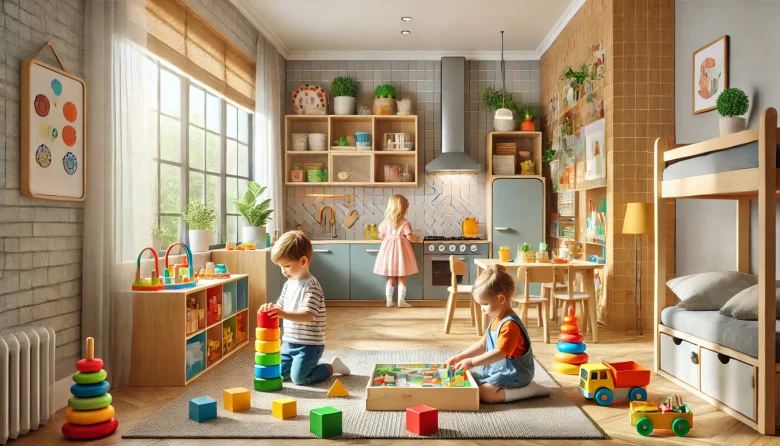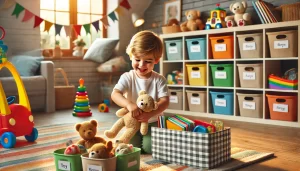Play is an essential part of early childhood development. It is not just a way for children to have fun; it is a powerful tool for learning, exploration, and skill-building. Through play, children develop cognitive, social, emotional, and physical abilities that lay the foundation for future success. In this article, we will explore why play is crucial for a child’s learning journey and how parents can create a stimulating environment at home.
Why Is Play Important for Learning?
Play Encourages Cognitive Development
Play helps children develop critical thinking, problem-solving skills, and creativity. Whether they are building with blocks, solving puzzles, or engaging in pretend play, they are constantly making decisions, testing ideas, and learning from their experiences.
Play Enhances Social and Emotional Skills
When children play with others, they learn how to communicate, share, negotiate, and resolve conflicts. Even when playing alone, they develop self-regulation skills and emotional resilience. Role-playing activities, for example, help them understand emotions and practice empathy.
Play Strengthens Physical Abilities
Active play, such as running, jumping, and climbing, improves motor skills, coordination, and overall health. Even simple activities like drawing or playing with clay enhance fine motor skills, which are essential for writing and other academic tasks.
Play Sparks Imagination and Creativity
Unstructured play allows children to explore their imagination freely. Whether they are pretending to be astronauts, chefs, or doctors, they are developing creative thinking skills that will benefit them throughout life.
Play Builds Confidence and Independence
Through play, children learn to take risks, experiment, and develop confidence in their abilities. When they solve a problem or create something on their own, they experience a sense of achievement that boosts their self-esteem.
How to Encourage Play-Based Learning at Home
Provide a Variety of Play Materials
Offer different types of toys and materials that stimulate creativity and problem-solving. Some great options include:
- Building blocks and construction sets
- Art supplies (crayons, paper, scissors, glue)
- Puzzles and board games
- Dress-up clothes for pretend play
- Outdoor equipment like balls and jump ropes
Create a Play-Friendly Environment
Designate a space in your home where children can play freely. Ensure that it is safe, inviting, and stocked with materials that encourage exploration and learning.
Balance Structured and Free Play
While structured activities (such as guided crafts or educational games) are beneficial, children also need unstructured playtime where they can create and explore on their own.
Join in the Fun
Parents can enhance learning through play by participating in activities. Playing together strengthens the parent-child bond and provides opportunities for teaching new concepts in an enjoyable way.
Encourage Outdoor Play
Spending time outside is great for physical development and sensory exploration. Activities like running, climbing, and playing in nature contribute to overall well-being.
Follow Your Child’s Interests
Every child is unique, and their interests will guide their learning. If your child loves animals, incorporate animal-themed play activities. If they enjoy music, provide instruments or engage in singing and dancing.
The Different Types of Play and Their Benefits
Not all play is the same, and each type of play provides unique benefits for a child’s development. Understanding these differences can help parents and educators incorporate a variety of activities into a child’s daily routine.
Physical Play
Physical activities like running, jumping, climbing, and dancing help children develop strength, coordination, and motor skills. This type of play is essential for a child’s physical health and also contributes to mental well-being by reducing stress and increasing focus.
Examples:
- Playing tag or hide-and-seek
- Riding a bicycle or scooter
- Practicing yoga or stretching exercises
Constructive Play
This type of play involves using materials to create something new. It encourages problem-solving, spatial awareness, and creativity.
Examples:
- Building towers with blocks or LEGO
- Creating models with clay or playdough
- Making crafts using recycled materials
Pretend Play (Imaginative Play)
Children engage in pretend play when they use their imagination to act out roles and scenarios. This type of play is excellent for emotional development, social skills, and creativity.
Examples:
- Playing “house,” “store,” or “doctor”
- Dressing up as different characters
- Using stuffed animals or dolls to create stories
Sensory Play
Sensory experiences help children explore their senses (touch, taste, smell, sight, and hearing) and develop cognitive skills through hands-on exploration.
Examples:
- Playing with water or sand
- Engaging in finger painting
- Exploring different textures with a sensory bin
Board Games and Rule-Based Play
Games that involve rules help children learn patience, strategy, and turn-taking. These games also enhance memory, logic, and problem-solving skills.
Examples:
- Simple card games like “Go Fish”
- Board games such as “Candy Land” or “Memory”
- Puzzles that challenge critical thinking
The Role of Culture in Play-Based Learning
The way children play varies across cultures, reflecting different traditions, values, and educational priorities. Understanding these differences can provide valuable insights into how play supports development worldwide.
Play in Different Cultures
- Nordic Countries (e.g., Finland, Sweden): Play-based learning is a core part of early education. Schools prioritize outdoor play and exploration over formal academics.
- Japan: Children are encouraged to engage in cooperative play and teamwork from an early age, with group activities being a fundamental part of preschool education.
- Africa: Many traditional African games involve storytelling and music, reinforcing oral traditions and social bonding.
- United States & Western Europe: There is a strong focus on structured play and educational toys, often integrating STEM (Science, Technology, Engineering, and Mathematics) elements into early learning.
What Can We Learn from These Approaches?
Parents can incorporate elements from different cultures into their child’s play routine. For example:
- Encourage more outdoor play like in Nordic countries.
- Foster cooperative games to teach teamwork, similar to Japanese schools.
- Integrate storytelling and music into daily activities, inspired by African traditions.
The Role of Technology in Play-Based Learning
Technology has transformed how children play and learn. While excessive screen time can have negative effects, when used correctly, digital tools can enhance play-based learning.
Educational Benefits of Technology in Play
- Interactive Learning Apps: Apps like ABCmouse or Khan Academy Kids can make learning fun by turning educational activities into engaging games.
- Augmented Reality (AR) Games: AR apps allow children to interact with virtual elements in the real world, enhancing creativity and problem-solving.
- Virtual Playdates: Video calls and online multiplayer games help children stay socially connected, even at a distance.
- Digital Creativity Tools: Apps for drawing, music creation, and storytelling can help children express their creativity in new ways.
How to Maintain a Healthy Balance
- Set screen time limits to ensure children also engage in physical and imaginative play.
- Choose high-quality educational content instead of passive entertainment.
- Encourage “co-play” by engaging with your child during digital activities.
How Play Prepares Children for the Future
While play may seem simple, it builds foundational skills that children will use throughout life. Here are some key long-term benefits:
Strengthens Problem-Solving Abilities
Children who engage in open-ended play (such as building structures or creating stories) learn how to analyze situations, make decisions, and adapt to challenges.
Improves Emotional Resilience
Play helps children navigate emotions by allowing them to express joy, frustration, excitement, and disappointment in a safe environment.
Encourages Lifelong Learning
When children experience the joy of discovery through play, they develop a love for learning that extends into adulthood.
Enhances Communication and Social Skills
Play teaches children how to collaborate, express their thoughts, and listen to others—skills that are essential for personal and professional success.
Boosts Creativity and Innovation
Creative play fosters innovation, a critical skill in a world that values original thinking and problem-solving.
Final Thoughts
Play is not just a pastime—it is an essential part of learning and growing. By understanding the different types of play, cultural influences, and the role of technology, parents and caregivers can create an enriching environment that supports holistic development.
By making play an integral part of a child’s daily routine, we empower them to become confident, curious, and capable individuals ready to take on the world.




